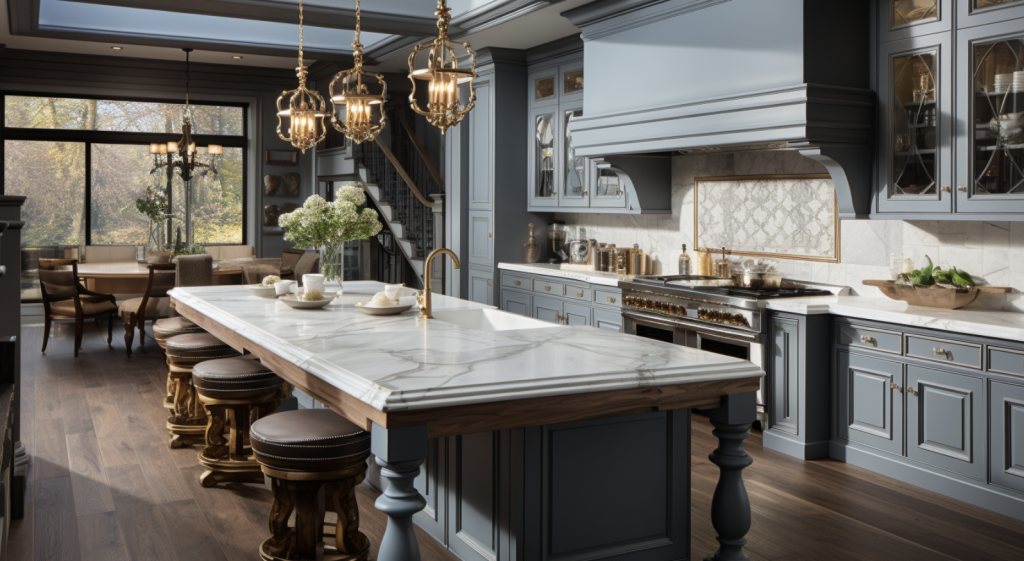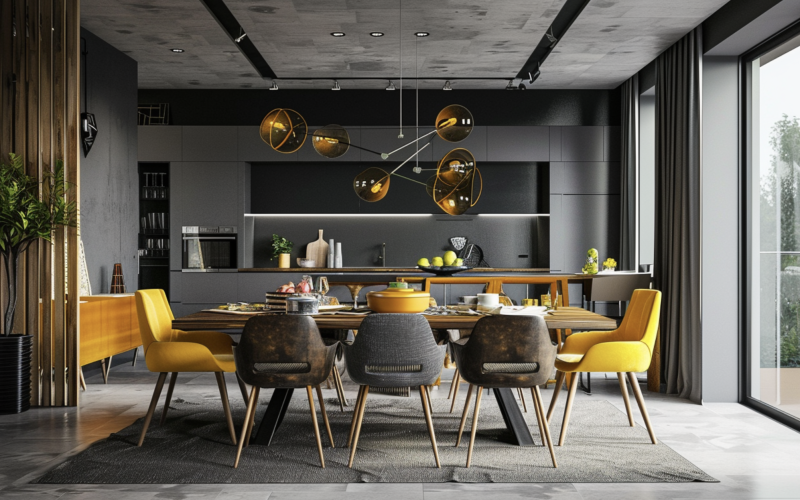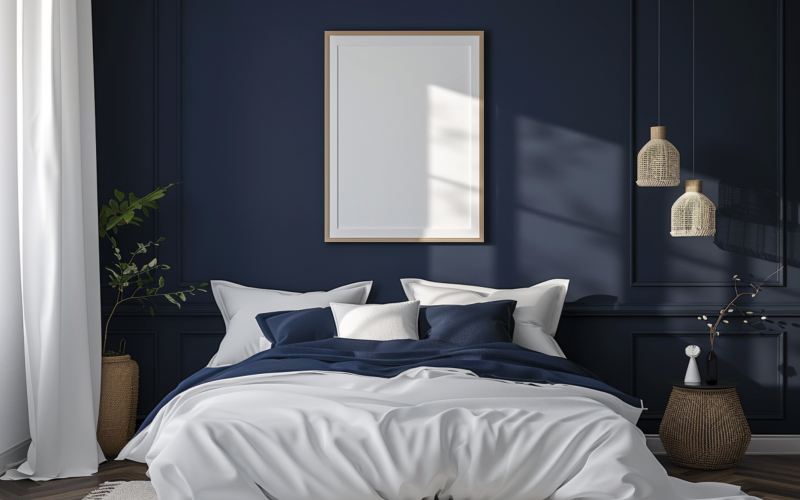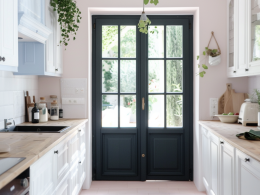Have you ever stared at your dining room walls, wondering how to make them pop? You’re not alone. Many homeowners struggle to find the perfect balance between style and comfort in this important space.
Sherwin-Williams gray colors offer a solution, providing a versatile backdrop for any dining room decor.
In this post, I’ll show you how to transform your dining area using these elegant shades. You’ll learn to choose the right gray, pair it with complementary colors, select furniture that stands out, and add accessories that bring the whole room together.
By the end, you’ll have all the tools you need to create an inviting and impressive dining room. Let’s dive in and discover how Sherwin-Williams Gray can elevate your dining experience.
Selecting the Right Shade of Gray
1. Importance of Undertones
Undertones make each gray unique. Cool grays have blue or green hints, creating a fresh, modern feel. Warm grays have beige or pink undertones, making spaces cozy and welcoming. Compare grays to pure white to spot the difference.
2. Popular Sherwin-Williams Grays
- Repose Gray: Light and versatile, slightly warm.
- Mindful Gray: Darker, balanced between cool and warm.
- Dorian Gray: Medium-dark, a bit warm for a cozy feel.
3. Choosing Based on Room Size and Light
Impact of natural and artificial lighting
Big rooms with lots of light can handle darker grays, while small or dim rooms do better with lighter grays. Consider your lighting—warm bulbs make grays look warmer, and cool LEDs make them cooler. Always test samples on your walls before deciding.
Complementary Color Schemes

1. Accents with Bold Colors
Adding pops of color with accessories. Gray walls are versatile. Adding bold colors helps in maintaining balance.
- Bright table runners or placemats
- Colorful artwork
- Bold-colored dining chairs
- Vibrant curtains
2. Neutral Palettes
Pairing with whites, beiges, and soft pastels. It creates a calmer look and makes an elegant, soothing dining room.
- Use white trim and ceiling
- Add beige or cream curtains
- Include soft pastel accessories
- Incorporate natural wood tones
3. Monochromatic Themes
Using different shades of gray for a cohesive look. It adds up a modern feel and creates a unified, sophisticated look.
- Use various shades of gray for walls, trim, and furniture
- Add interest with different textures
- Mix light and dark grays
Furniture Selection
1. Material Choices
- Wood: Adds warmth to gray rooms. Light woods brighten, and dark woods create contrast.
- Metal: Offers a sleek, modern look. Silver tones complement cool grays, and gold warms up the space.
- Upholstered: Adds comfort and color. Choose fabrics that complement or contrast your gray walls.
2. Styles
-
Modern: Clean lines and minimalist designs work well with cool grays.
- Classic: Traditional pieces pair nicely with warm grays for timeless elegance.
- Rustic: Natural wood furniture adds character to light or medium grays.
- Transitional: Blends modern and traditional, versatile with most gray shades.
3. Color Coordination
- Match: Choose furniture in similar gray tones for a cohesive look.
- Contrast: Use white, black, or bold colors to make pieces stand out.
- Complement: Wood tones or soft colors can enhance the gray without overpowering it.
Decor and Accessories
1. Wall Art and Mirrors
- Large art pieces: Choose bold colors or black and white for contrast
- Gallery walls: Mix different-sized frames for visual interest
- Mirrors: Reflect light and make the room feel bigger
- Placement: Hang at eye level for best impact
2. Textiles
- Rugs: Define the dining area and add warmth
- Curtains: Frame windows and soften gray walls
- Cushions: Add comfort to chairs and inject color
- Mix textures: Combine smooth, rough, and patterned fabrics
3. Table Settings
- Dinnerware: White for versatility or colorful for contrast
- Centerpieces: Fresh flowers or modern sculptures add life
- Table linens: Use placemats or runners for pops of color
- Mix metals: Combine silver, gold, or copper accents for depth
Lighting Solutions
1. Ambient Lighting
- Chandeliers: Create a focal point and set the room’s tone
- Pendant lights: Work well over dining tables, add style
- Recessed lighting: Provides even illumination, good for larger rooms
2. Task Lighting
- Floor lamps: Add light to dark corners, create cozy spots
- Table lamps: Offer soft light on sideboards or console tables
3. Accent Lighting
- Wall sconces: Highlight artwork or architectural features
- Under-cabinet lighting: Illuminates serving areas, adds depth
Creating Visual Interest
Feature walls can add interest to your gray dining room. Choose one wall for patterned wallpaper or a different shade of gray paint. Textured paint techniques like sponging can create unique looks, adding depth and contrast.
Architectural details enhance character. White wainscoting contrasts with gray walls, while crown molding defines the space. Exposed ceiling beams add warmth and interest. Chair rails can break up wall space decoratively, giving your room a polished look.
Greenery softens the space and adds natural elements. Use large floor plants in corners, hanging plants for vertical interest, and small herbs on the table. A vertical garden can make a bold statement.
Balance functionality with aesthetics. Choose comfortable seating, ensure traffic flow, and incorporate stylish storage like sideboards. This creates a beautiful and practical dining room.
Maintain the look by gently cleaning gray walls with appropriate cleaners. Regular dusting and vacuuming keep the room fresh. These habits ensure your gray-themed dining room remains inviting and stylish for years.
Conclusion
As we wrap up our journey through the world of gray dining rooms, remember that the key to success lies in balancing style with functionality.
Your Sherwin-Williams gray walls provide a versatile canvas for creating an inviting and impressive space. Whether you opt for bold accents, neutral palettes, or a monochromatic theme, the right shade of gray can elevate your dining experience.
Remember to add personal touches with carefully chosen furniture, lighting, and decor. Most importantly, make it a space where you and your loved ones want to gather.
With these tips, you can transform your dining room into a stylish haven that reflects your unique taste. So, create a dining space you’ll love for years.
Frequently Asked Questions
What’s the Best Lighting for A Gray Dining Room?
Use a mix of lighting types. Install a statement chandelier or pendant light. Add wall sconces or table lamps for ambiance. Consider dimmer switches for flexibility.
What Color Chairs Work Best with Gray Walls?
Many colors work well. White chairs create a clean look, wooden chairs add warmth, and colorful chairs can be fun accents. Choose based on your overall style and other decor.
Can I Mix Different Grays in My Dining Room?
Yes, mixing grays adds depth. Use lighter grays for walls and darker grays for accents. Combine cool and warm grays for interest. Keep undertones consistent for a cohesive look.











